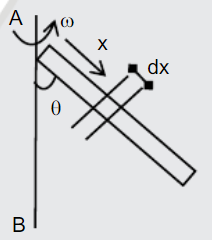Assertion: If the head of a right handed screw rotates with the body, the screw advances in the direction of the angular velocty.
Reason: For rotation about a fixed axis, the angular velocity vector lies along the axis of rotation.
If both assertion and reason are true and reason is the correct explanation of assertion.
If both assertion and reason are true but reason is not the correct explanation of assertion
If assertion is true but reason is false.
If both assertion and reason are false.
The correct Answer is:a
To solve the question, we need to analyze both the assertion and the reason provided.
1. Understanding the Assertion:
- The assertion states that if the head of a right-handed screw rotates with the body, the screw advances in the direction of the angular velocity.
- A right-handed screw moves forward when turned clockwise. This is based on the right-hand rule, where if you curl the fingers of your right hand in the direction of rotation (clockwise), your thumb points in the direction of the screw's advancement.
2. Applying the Right-Hand Rule:
- When you rotate the screw clockwise, the angular velocity vector points along the axis of rotation (outward from the screw head).
- According to the right-hand rule, the thumb (representing the direction of the angular velocity) indicates the direction in which the screw advances.
3. Understanding the Reason:
- The reason states that for rotation about a fixed axis, the angular velocity vector lies along the axis of rotation.
- This is a fundamental property of rotational motion. The angular velocity vector (often denoted as →ω) indeed points along the axis of rotation.
4. Evaluating the Assertion and Reason:
- Both the assertion and reason are correct.
- The reason provides a valid explanation for the assertion because it describes the relationship between angular velocity and the direction of motion for a rotating object.
5. Conclusion:
- Since both the assertion and reason are true, and the reason correctly explains the assertion, we can conclude that the correct answer is that both the assertion and reason are true, and the reason is the correct explanation of the assertion.
Final Answer:
Both assertion and reason are true, and the reason is the correct explanation of the assertion.
---
- The assertion states that if the head of a right-handed screw rotates with the body, the screw advances in the direction of the angular velocity.
- A right-handed screw moves forward when turned clockwise. This is based on the right-hand rule, where if you curl the fingers of your right hand in the direction of rotation (clockwise), your thumb points in the direction of the screw's advancement.
- When you rotate the screw clockwise, the angular velocity vector points along the axis of rotation (outward from the screw head).
- According to the right-hand rule, the thumb (representing the direction of the angular velocity) indicates the direction in which the screw advances.
- The reason states that for rotation about a fixed axis, the angular velocity vector lies along the axis of rotation.
- This is a fundamental property of rotational motion. The angular velocity vector (often denoted as →ω) indeed points along the axis of rotation.
- Both the assertion and reason are correct.
- The reason provides a valid explanation for the assertion because it describes the relationship between angular velocity and the direction of motion for a rotating object.
- Since both the assertion and reason are true, and the reason correctly explains the assertion, we can conclude that the correct answer is that both the assertion and reason are true, and the reason is the correct explanation of the assertion.
Both assertion and reason are true, and the reason is the correct explanation of the assertion.
Topper's Solved these Questions
- SYSTEM OF PARTICLES AND ROTATIONAL MOTIONSBOOK - NCERT FINGERTPS ENGLISHCHAPTER - SYSTEM OF PARTICLES AND ROTATIONAL MOTIONSEXERCISE - Kinematics Of Rotational Motion About A Fixed Axis
3 Videos
- SYSTEM OF PARTICLES AND ROTATIONAL MOTIONSBOOK - NCERT FINGERTPS ENGLISHCHAPTER - SYSTEM OF PARTICLES AND ROTATIONAL MOTIONSEXERCISE - Higher Order Thinking Skills
8 Videos
- SYSTEM OF PARTICLES AND ROTATIONAL MOTIONSBOOK - NCERT FINGERTPS ENGLISHCHAPTER - SYSTEM OF PARTICLES AND ROTATIONAL MOTIONSEXERCISE - NCER EXAMPLAR PROBLEMS
8 Videos
- PRACTICE PAPERSBOOK - NCERT FINGERTPS ENGLISHCHAPTER - PRACTICE PAPERSEXERCISE - All Questions
150 Videos
- THERMAL PROPERTIES OF MATTERBOOK - NCERT FINGERTPS ENGLISHCHAPTER - THERMAL PROPERTIES OF MATTEREXERCISE - Assertion And Reason
10 Videos
Similar Questions
Knowledge Check
When a mass is rotating in a plane about a fixed point its angular momentum is directed along
Athe radiusBthe tangent to orbitCline at an anlage of 45∘ to the plane of rotationDthe axis of rotation
Angular momentum of a rigid body rotating about a fixed Axis with angular velocity →ω
View SolutionA rod is rotating with angular velocity ω about axis AB. Find cosθ.

View SolutionShow on a diagram the vector that would represent the angular velocity of the earth rotating about its axis.
View SolutionWhen a mass is rotating in a plane about a fixed point, its angular momentum is directed along.
View SolutionWhen a mass is rotating in a plane about a fixed point, its angular momentum is directed along.
View SolutionIf I, α and τ are the moment of inertia, angular acceleration and torque respectively of a body rotating about an axis with angular velocity ω then,
View Solution"The rotational vectors are represented by straight lines lying along axis of rotation". Why ?
View Solution
